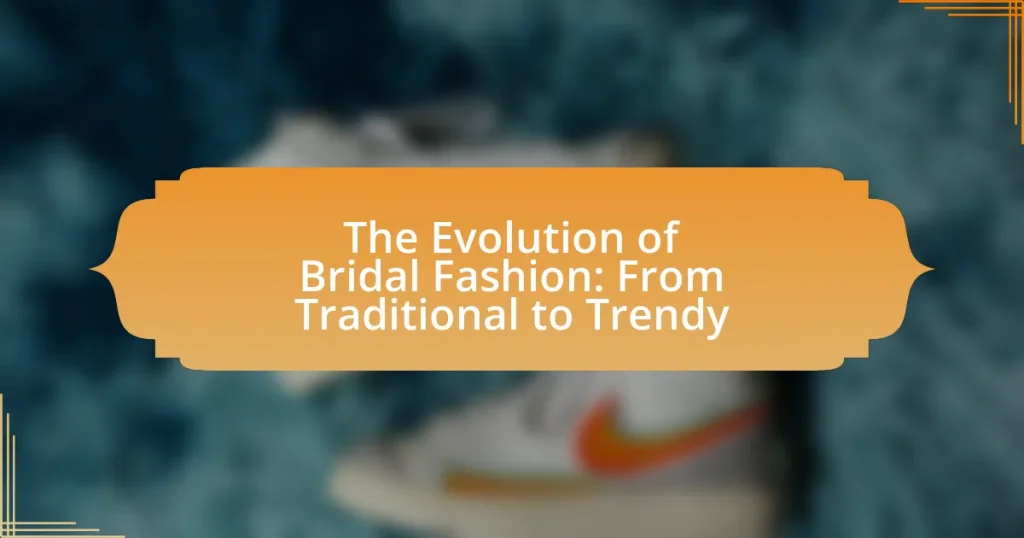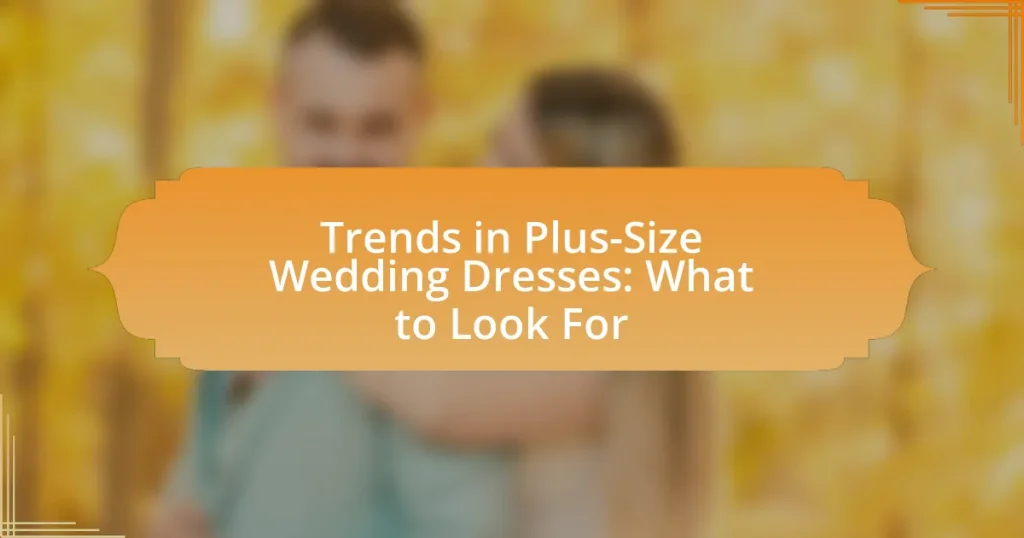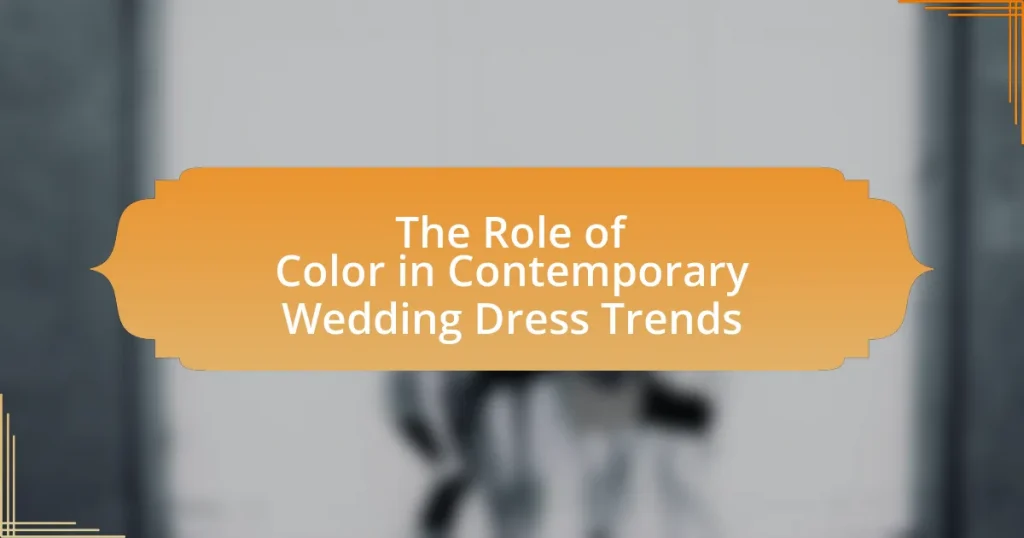The article examines the evolution of bridal fashion, tracing its development from traditional styles to contemporary trends. It highlights key historical influences, such as Queen Victoria’s introduction of the white wedding dress and the impact of societal changes, including women’s rights movements and the rise of individualism. The discussion covers how bridal attire has diversified over the decades, with modern brides embracing personalization, sustainability, and non-traditional styles. Additionally, the article explores the role of fashion designers, celebrity weddings, and social media in shaping current bridal fashion trends, emphasizing the shift towards unique expressions of personal style.
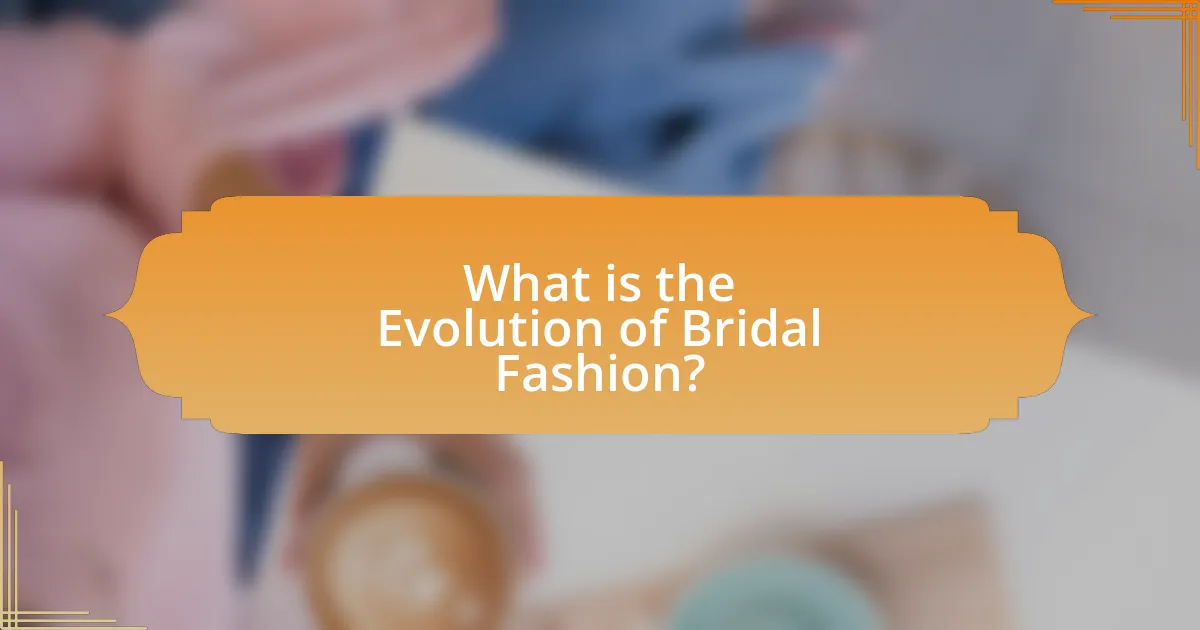
What is the Evolution of Bridal Fashion?
The evolution of bridal fashion reflects significant cultural and societal changes over time. Initially, brides wore their best dresses regardless of color, with white becoming popular in the 19th century after Queen Victoria wore a white gown for her wedding to Prince Albert in 1840. This shift established white as the traditional color for weddings in Western cultures.
In the early 20th century, bridal fashion began to incorporate more elaborate designs, influenced by the rise of fashion houses and the availability of new fabrics. The 1920s introduced shorter hemlines and more relaxed silhouettes, while the post-World War II era saw a return to more formal styles, exemplified by the iconic ball gown silhouette.
The late 20th century and early 21st century witnessed a diversification in bridal fashion, with an emphasis on personalization and non-traditional styles. Brides began to choose colors, patterns, and styles that reflected their individual tastes rather than adhering strictly to tradition. This shift has been supported by the rise of social media and celebrity influence, which have popularized a wide range of bridal aesthetics, from bohemian to minimalist.
Overall, bridal fashion has evolved from a uniform tradition to a diverse expression of personal style, influenced by historical events, cultural shifts, and individual preferences.
How has bridal fashion changed over the decades?
Bridal fashion has evolved significantly over the decades, transitioning from traditional, conservative styles to more diverse and expressive designs. In the early 20th century, brides typically wore long, flowing gowns with high necklines and long sleeves, reflecting societal norms of modesty. By the 1920s, flapper-inspired silhouettes emerged, featuring shorter hemlines and more relaxed fits, symbolizing women’s growing independence.
The 1950s brought a return to more structured designs, with voluminous skirts and fitted bodices, influenced by icons like Grace Kelly. The 1970s introduced bohemian styles, characterized by flowing fabrics and less formal aesthetics, aligning with the counterculture movement. In the 1980s, extravagant gowns with puffed sleeves and dramatic trains became popular, influenced by royal weddings and Hollywood glamour.
The 1990s saw a shift towards minimalism, with sleek lines and simpler designs gaining favor, while the 2000s embraced a mix of vintage and modern elements, allowing for personalized expressions of style. Today, bridal fashion is marked by inclusivity and innovation, with designers offering a wide range of styles, fabrics, and colors, reflecting individual tastes and cultural influences. This evolution showcases how bridal fashion has adapted to changing societal values and personal expressions over time.
What were the key influences on bridal fashion in the early 20th century?
Key influences on bridal fashion in the early 20th century included the rise of the white wedding dress, popularized by Queen Victoria’s marriage to Prince Albert in 1840, and the impact of social changes such as women’s suffrage and the flapper movement. The adoption of the white dress became a symbol of purity and was widely embraced by brides, leading to a shift from traditional colored gowns. Additionally, advancements in textile manufacturing allowed for more intricate designs and embellishments, reflecting the era’s fashion trends. The influence of Hollywood and celebrity culture also played a significant role, as film stars set new standards for bridal aesthetics, further shaping public perceptions of wedding attire.
How did societal changes impact bridal fashion in the 1960s and 1970s?
Societal changes in the 1960s and 1970s significantly transformed bridal fashion by introducing more relaxed and diverse styles that reflected the era’s cultural shifts. The rise of the feminist movement and changing attitudes towards marriage led to a departure from traditional, formal wedding gowns, with many brides opting for shorter hemlines, colorful dresses, and non-traditional fabrics. For instance, the popularity of the mini dress and bohemian styles mirrored the counterculture movement, allowing brides to express individuality rather than conform to conventional norms. Additionally, the influence of celebrities, such as the iconic wedding of actress Mia Farrow in 1970, showcased a more casual approach to bridal attire, further encouraging brides to embrace personal style over tradition.
What are the defining characteristics of traditional bridal fashion?
Traditional bridal fashion is characterized by specific elements such as the use of white or ivory gowns, intricate lace and embroidery, and cultural symbols that reflect heritage. Historically, the white wedding dress became popular in the 19th century, particularly after Queen Victoria wore one in 1840, symbolizing purity and innocence. Additionally, traditional bridal attire often includes veils, which signify modesty, and accessories like tiaras or floral crowns that enhance the overall look. Cultural variations also play a significant role, with different regions incorporating unique fabrics, colors, and designs that represent local customs and traditions.
What materials and styles were commonly used in traditional bridal gowns?
Traditional bridal gowns commonly utilized materials such as silk, satin, lace, and tulle, along with styles that included ball gowns, A-line silhouettes, and empire waist designs. Silk and satin provided a luxurious sheen and smooth texture, while lace added intricate detailing and elegance. Tulle was often used for veils and overlays, enhancing the gown’s ethereal quality. The ball gown style, characterized by a full skirt and fitted bodice, was particularly popular in Western cultures, reflecting a sense of grandeur and formality. A-line silhouettes offered a more understated elegance, flattering various body types, while empire waist designs emphasized the bust and flowed gracefully to the hem. These materials and styles have historical significance, as they were often chosen to symbolize purity and celebration in various cultures.
How did cultural backgrounds influence traditional bridal attire?
Cultural backgrounds significantly influenced traditional bridal attire by dictating the materials, colors, and styles used in wedding garments. For instance, in many Asian cultures, red symbolizes good fortune and joy, leading to the prevalence of red bridal dresses, such as the Chinese qipao. In contrast, Western cultures often favor white dresses, a tradition popularized by Queen Victoria in the 19th century, symbolizing purity and new beginnings. Additionally, specific cultural practices, such as the use of intricate embroidery or regional textiles, reflect local heritage and craftsmanship, further shaping the unique characteristics of bridal attire across different societies.
What trends have emerged in modern bridal fashion?
Modern bridal fashion has seen a shift towards minimalism, sustainability, and personalization. Designers are increasingly favoring clean lines and simple silhouettes, moving away from overly ornate designs. This trend is supported by a growing consumer preference for eco-friendly materials and ethical production practices, reflecting a broader societal shift towards sustainability in fashion. Additionally, brides are opting for customizable options, allowing them to express their individuality through unique fabrics, colors, and styles, which enhances the personal significance of their wedding attire.
What are the most popular styles in contemporary bridal gowns?
The most popular styles in contemporary bridal gowns include A-line silhouettes, ball gowns, and sheath dresses. A-line gowns are favored for their universally flattering shape, which gently flares from the waist, making them suitable for various body types. Ball gowns, characterized by their voluminous skirts and fitted bodices, evoke a classic fairytale look and remain a staple for brides seeking a dramatic appearance. Sheath dresses, which hug the body and flow straight down, are increasingly popular for their sleek and modern aesthetic, appealing to brides who prefer a minimalist style. These styles reflect current trends in bridal fashion, emphasizing both elegance and individuality.
How do modern brides incorporate personal style into their wedding attire?
Modern brides incorporate personal style into their wedding attire by selecting unique designs, fabrics, and accessories that reflect their individuality. This customization often includes choosing non-traditional colors, such as blush or navy, instead of classic white, and opting for personalized embellishments like custom embroidery or unique lace patterns. Additionally, many brides now mix and match separates, such as pairing a stylish top with a flowing skirt, allowing for greater expression of personal taste. The trend towards personalized wedding attire is supported by the rise of bespoke bridal boutiques and online platforms that offer customizable options, enabling brides to create looks that resonate with their personal aesthetics and cultural backgrounds.

What factors have influenced the shift from traditional to trendy bridal fashion?
The shift from traditional to trendy bridal fashion has been influenced by changing societal norms, increased access to information, and the rise of social media. Societal norms have evolved, leading to a greater acceptance of diverse styles and personal expression in weddings, moving away from rigid traditions. Access to information has expanded through platforms like Pinterest and Instagram, allowing brides to explore a wider range of styles and inspirations. Social media has played a crucial role in popularizing non-traditional bridal looks, as influencers and celebrities showcase unique designs, encouraging brides to embrace individuality over convention.
How have fashion designers shaped the evolution of bridal wear?
Fashion designers have significantly shaped the evolution of bridal wear by introducing innovative styles, materials, and cultural influences that reflect changing societal norms. For instance, in the 20th century, designers like Vera Wang revolutionized bridal fashion by moving away from traditional white gowns to incorporate diverse colors and modern silhouettes, catering to contemporary tastes. Additionally, the rise of celebrity weddings has influenced bridal trends, with designers such as Monique Lhuillier and Oscar de la Renta creating iconic gowns that set new standards for elegance and creativity. This evolution is evidenced by the increasing popularity of non-traditional bridal attire, such as jumpsuits and colored dresses, showcasing how designers adapt to and shape consumer preferences over time.
What role do fashion shows play in setting bridal trends?
Fashion shows play a crucial role in setting bridal trends by showcasing the latest designs and styles from top designers, influencing consumer preferences and industry standards. These events serve as a platform for designers to present their collections, often featuring innovative fabrics, silhouettes, and themes that capture the attention of both the media and potential brides. For instance, the New York Bridal Fashion Week has historically introduced trends that later dominate the bridal market, such as the rise of minimalist designs in the late 2010s. By highlighting these trends, fashion shows not only dictate what is fashionable but also inspire bridal boutiques and retailers to stock similar styles, thereby shaping the overall direction of bridal fashion.
How do celebrity weddings impact bridal fashion choices?
Celebrity weddings significantly influence bridal fashion choices by setting trends that many brides aspire to emulate. High-profile weddings often showcase unique and extravagant designs, which can lead to increased demand for similar styles among the general public. For instance, when celebrities like Meghan Markle or Kim Kardashian wore specific designers or styles, those choices sparked widespread interest and inspired bridal collections that mirrored those looks. This phenomenon is supported by data indicating that bridal boutiques frequently report a surge in inquiries for dresses resembling those worn by celebrities shortly after their weddings.
What cultural shifts have contributed to changing bridal fashion norms?
Cultural shifts such as the rise of individualism, increased gender equality, and the influence of social media have significantly contributed to changing bridal fashion norms. Individualism has led brides to prioritize personal expression over traditional expectations, resulting in diverse styles that reflect their unique identities. Increased gender equality has encouraged a departure from conventional gender roles, allowing for non-traditional attire and co-ed wedding parties. Additionally, social media platforms have democratized fashion trends, enabling brides to access a wider array of styles and inspirations, thus fostering a culture of experimentation and personalization in bridal wear.
How has the rise of social media affected bridal fashion trends?
The rise of social media has significantly transformed bridal fashion trends by increasing accessibility to diverse styles and fostering real-time inspiration among brides. Platforms like Instagram and Pinterest allow brides to discover and share a wide array of wedding dress designs, leading to a shift from traditional silhouettes to more contemporary and personalized options. For instance, a survey by The Knot in 2021 indicated that 75% of brides used social media for wedding planning, showcasing the influence of online platforms on their fashion choices. This trend has resulted in a greater emphasis on unique, non-traditional elements, such as colored gowns and alternative fabrics, reflecting individual personalities rather than adhering strictly to conventional bridal aesthetics.
What impact do changing gender roles have on bridal attire choices?
Changing gender roles significantly influence bridal attire choices by promoting inclusivity and diversity in styles. As societal norms evolve, traditional expectations of brides wearing white gowns are challenged, leading to a broader acceptance of various colors, styles, and even non-traditional outfits like suits or jumpsuits. This shift reflects a growing recognition of individual expression and personal identity in weddings, allowing brides to choose attire that resonates with their unique personalities rather than conforming to historical conventions. For instance, a survey by The Knot in 2021 indicated that 30% of brides opted for non-white dresses, showcasing a clear departure from traditional norms.
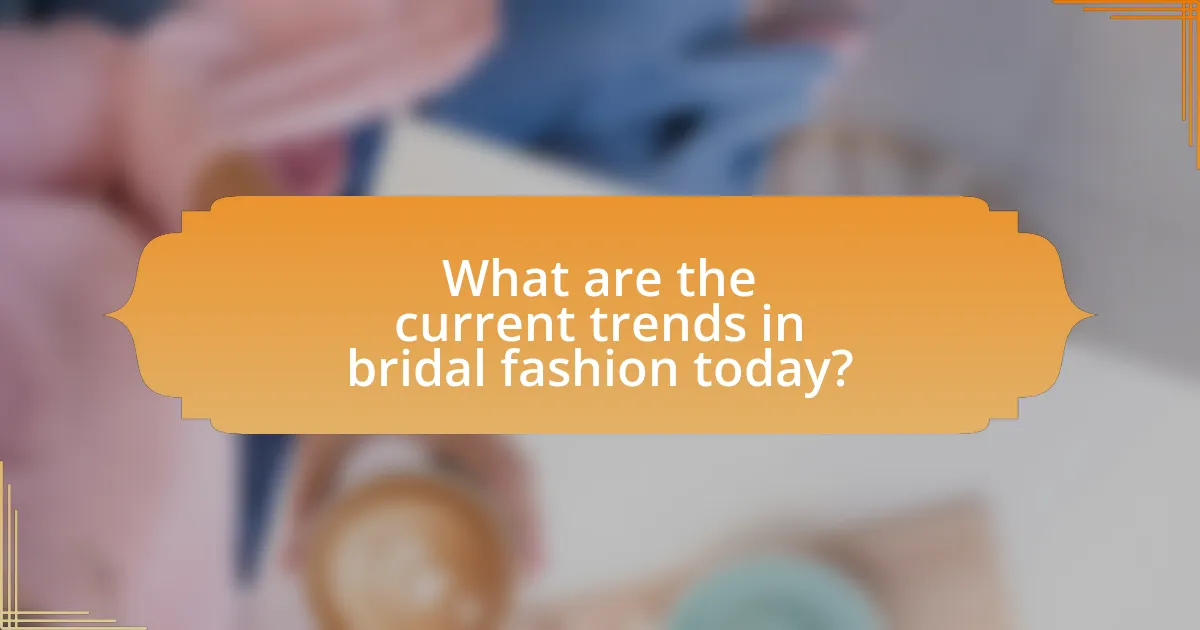
What are the current trends in bridal fashion today?
Current trends in bridal fashion today include a shift towards minimalist designs, sustainable materials, and personalized elements. Minimalist wedding dresses, characterized by clean lines and simple silhouettes, have gained popularity as brides seek elegance without excess. Additionally, the use of eco-friendly fabrics and ethical production practices reflects a growing awareness of sustainability in the fashion industry. Personalized touches, such as custom embroidery or unique accessories, allow brides to express their individuality, making each wedding look distinct. These trends are supported by industry reports indicating a significant rise in demand for sustainable and personalized bridal options, highlighting a transformation in consumer preferences.
What styles are dominating the bridal fashion scene in recent years?
Contemporary bridal fashion is currently dominated by styles such as minimalist designs, bohemian aesthetics, and vintage-inspired gowns. Minimalist designs emphasize clean lines and simple silhouettes, reflecting a shift towards understated elegance, while bohemian styles incorporate flowing fabrics and relaxed fits, appealing to brides seeking a more casual and free-spirited look. Vintage-inspired gowns draw on historical elements, often featuring intricate lace and classic silhouettes, which resonate with brides looking for timeless romance. These trends have been validated by industry reports, including the 2023 Bridal Fashion Week, which highlighted these styles as leading choices among designers and consumers alike.
How are sustainable practices influencing modern bridal fashion?
Sustainable practices are significantly influencing modern bridal fashion by promoting eco-friendly materials and ethical production methods. Designers are increasingly using organic fabrics, recycled materials, and sustainable sourcing to create wedding gowns, which reduces environmental impact. For instance, brands like Reformation and Stella McCartney have pioneered the use of sustainable textiles, showcasing that eco-conscious choices can align with high fashion. Additionally, the rise of rental services and second-hand markets for bridal wear reflects a shift towards minimizing waste and encouraging circular fashion. This trend is supported by consumer demand for transparency and responsibility in the fashion industry, as evidenced by a 2021 survey indicating that 66% of consumers are willing to pay more for sustainable brands.
What are the most sought-after colors and fabrics for contemporary brides?
The most sought-after colors for contemporary brides include soft pastels like blush and lavender, as well as bold hues such as deep red and navy blue. Fabrics that are popular among modern brides consist of lightweight materials like chiffon and tulle, along with luxurious options such as silk and lace. These choices reflect a shift towards personalization and versatility in bridal fashion, aligning with current trends that emphasize individual expression and comfort.
How can brides choose the right style for their wedding?
Brides can choose the right style for their wedding by considering their personal taste, the wedding theme, and current fashion trends. Personal taste is crucial as it reflects the bride’s individuality; for instance, a bride who prefers vintage aesthetics may opt for a classic lace gown. The wedding theme also plays a significant role; a beach wedding may call for a more relaxed, flowing dress, while a formal ceremony might require a more structured silhouette. Additionally, staying informed about current bridal fashion trends can help brides select styles that are both contemporary and timeless. Research indicates that 70% of brides prioritize personal style over trends, emphasizing the importance of aligning choices with individual preferences.
What tips can help brides find a gown that reflects their personality?
Brides can find a gown that reflects their personality by considering their personal style, preferences, and the overall theme of their wedding. Identifying whether they prefer classic, modern, bohemian, or vintage styles helps narrow down options. Additionally, trying on various silhouettes and fabrics allows brides to see what feels most comfortable and authentic to them. Research shows that brides who align their gown choices with their personal aesthetics report higher satisfaction with their overall wedding experience. This connection between personal style and gown selection is supported by studies indicating that emotional resonance with attire enhances the joy of the occasion.
How can brides balance tradition and modernity in their wedding attire?
Brides can balance tradition and modernity in their wedding attire by incorporating classic elements with contemporary styles. For instance, a bride might choose a traditional silhouette, such as an A-line gown, while opting for modern fabrics like lace or chiffon, which offer a fresh twist. Additionally, accessories can play a crucial role; wearing a vintage veil with a sleek, modern dress can create a harmonious blend of both worlds. This approach allows brides to honor cultural heritage while expressing personal style, reflecting the evolving nature of bridal fashion.
What are the best practices for selecting bridal fashion?
The best practices for selecting bridal fashion include understanding personal style, considering body shape, setting a budget, and researching current trends. Personal style should reflect the bride’s personality, ensuring comfort and confidence on the wedding day. Body shape plays a crucial role in determining which silhouettes and fabrics will enhance the bride’s figure, as certain styles flatter specific shapes better. Establishing a budget is essential to narrow down options and avoid overspending, as bridal fashion can vary significantly in price. Researching current trends helps brides stay informed about popular styles, fabrics, and colors, allowing them to make choices that feel contemporary yet timeless. These practices are supported by industry insights, such as the 2022 Bridal Fashion Week trends, which highlighted the importance of personalization and body positivity in bridal wear.
